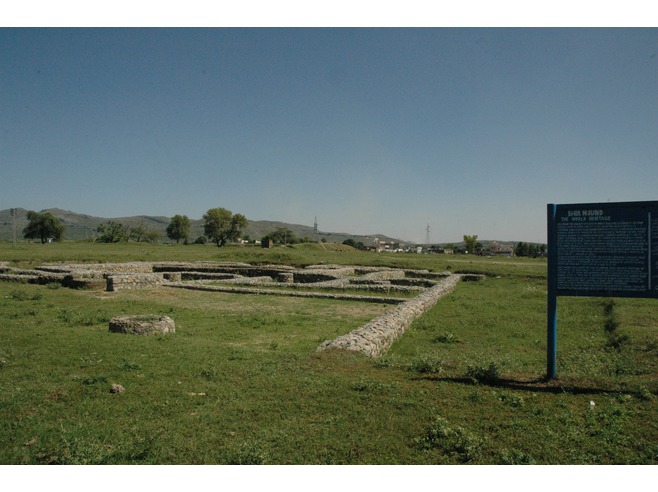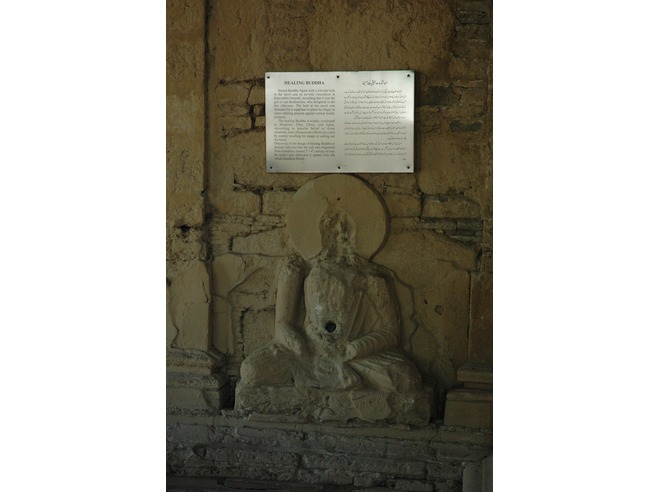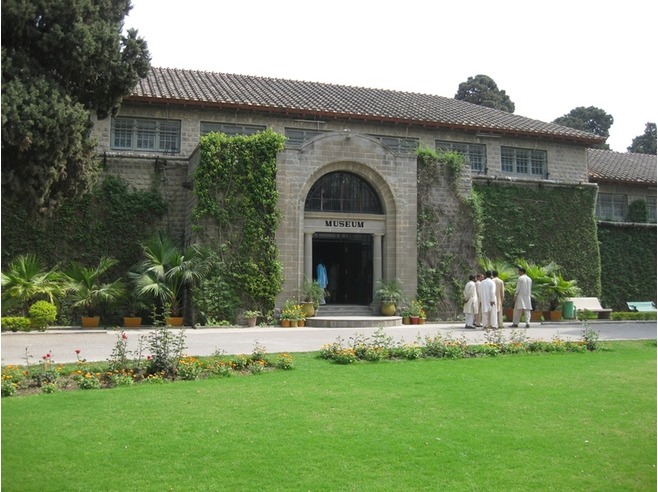Taxila – Jaulian II
On the eastern side of the stupa plinth is the Healing Buddha, which is inscribed in the Kharosthi script with the name of the donor, the monk Budhamitra Dharmanandin (Budhamitra who delighted in the law). It has a hole at its navel, intended for supplicants to place their fingers in when offering prayers against certain bodily ailments.
The healing Buddha is widely worshipped in Myanmar, Tibet, China and Japan. According to popular belief in those countries, some illnesses are effectively cured just by touching his image or calling out his name. The discovery of this image of the healing Buddha at Jaulian indicates that the cult probably originated from Gandhara around the 3rd to 4th centuries C.E, possibly earlier, and spread from there around the Buddhist world.
Bhir Mound
Bhir Mound is the oldest city site of ancient Taxila, and has been excavated several times over the last century. It contains several strata of ruins: the earliest dating from the 6th-5th century BCE; the second from the 4th century BCE which existed at the time of Alexander the Great’s invasion; the third from the time of the Maurya kings in the 3rd c. BCE, and the last containing post-Mauryan structures.

Taxila – Sirkap II
There are only the foundations of buildings visible, but signs give clear descriptions of the purposes of many of the buildings.
Photo 1 shows a circular stupa, which stands in the courtyard of a private house. What makes this little stupa particularly interesting is that it is older than the rest of the house, as it was built on a lower level. It dates to around the 1st century BCE or possibly early 1st century CE, and is in fact thought to be the earliest Buddhist structure here, and the oldest stupa on the Indian subcontinent. Its location in a small enclosure in a house indicates that it was used for private worship only, although it has been postulated that the stupa was disturbed by an earthquake in the 1st century CE and the wall was built around it to preserve it when the city was rebuilt.
Photo 2 shows the Double-headed Eagle stupa, dating again from 1st c BCE – 1st c. CE. It measures about 6.5 by 8 metres, and is faced with squared kanjur stone, with a rubble core. Around the base is a well-cut moulding, with Corinthian style pilasters. In between the columns Greek temples and Hindu shrines are depicted, and on top of these sanctuaries are double headed eagles. This motif, which gives the stupa its name, may originally have come from Babylon, and from where it spread to the Scythians who must have brought it to Taxila.

Taxila_Sirkap_II-Taxila
Photo 3 shows another stupa, said to be in the shape of a Roman temple. It dates from the 1st century BCE.
Taxila – Sirkap
Sirkap is close to the museum, so is easily accessible on foot.
This site is the second city of ancient Taxila (Taxila II on the maps) and is presently known as Sirkap after the name of a wicked character from a folk legend, who lived and died here. It was excavated first in 1912-30 under the supervision of Sir John Marshall (who directed the excavation of many of the other sites in the area), and again in 1944-5 by Sir Mortimer Wheeler.
The remains belong to four distinct, superimposed periods: Pre-Greek, Greek, Scythians and Parthians. The city itself was founded in the early 2nd century C.E. by the Bactrian Greek king Demetrius, when Taxila was annexed by that Indo-Greek kingdom around 180 BCE. Sirkap was built on the opposite bank of the river from the first city of Taxila (Taxila I) During this new period of Bactrian Greek rule, several dynasties likely ruled from the city as their capital. It is said to have been rebuilt by Menander I later that century.
The city was well planned and fortified, and built in the Ionic and Corinthian style of architecture. It was rebuilt again by the Parthian king Gondophares following the Greek pattern, with its main street in the middle studded with shops and places of worship. The king’s palace was close to the eastern gate.
This site was probably abandoned some time after 60 A.D. when the great Kushians swept away the Parthians; they founded Taxila III, Sirsukh, further up the hill, in 80 A.D.
Taxila – Jandial
Just down the hill from both Jaulian and Mohra Moradu is Jandial, a sanctuary which looks remarkably similar to a Greek temple. This is perhaps only to be expected, since Jandial is only 650 meters from the part of Taxila that is known as Sirkap, which was founded and rebuilt in the second century BCE by the Indo-Greek kings Demetrius and Menander. However, it is slightly odd that the Jandial sanctuary appears to have been a Zoroastrian place of worship.
It is built in the form of a distyle-in-antis (i.e., it had two columns between two projecting walls). A pronaos (entrance hall), naos, (cult room, see 2nd photo) and opisthodomos (back chamber) can also be discerned. Stairs indicate that there was once a second floor and windows, unlike a Greek temple, but much more appropriate for a temple dedicated to Ahura Mazda, which would require openings to allow in oxygen for the sacred fire.
Based on the numismatic evidence found here, the temple seems to have survived until the 6th or 7th century C.E.
Taxila – Mohra Moradu
Mohra Moradu is, like Jaulian, a Buddhist complex consisting of a stupa and a monastery. It was excavated in 1915-16. It was probably constructed in the 2nd century C.E., but was renovated extensively in the 4th-5th centuries.
The stupa to the west stands on a 16ft plinth, with stone mouldings and slender vertical pilasters. It was decorated with the finest stucco figures of the Buddha, Boddhisatvas and Devas (some of which have been removed to the museum).
The typical rectangular Gandharan monastery has a square open courtyard surrounded by 27 cells for the accommodation of teachers and students. There is a bathroom in one corner. In monastic cell number 9 is a 20 foot tall votive stupa (photo 3) constructed in memory of a venerated teacher who had lived and died there.
Taxila – Jaulian
The first site we visited was Jaulian, a Buddhist stupa with a vihara (or monastery) and university on a hill 300 feet above the surrounding countryside. They date to the Kushan Era (between 1st and 5th centuries C.E.)
Due to the economic strain which followed the invasion of the White Huns towards the end of the 5th century it was deserted and left to share the decay of the other Buddhist establishments in Taxila valley.
The site was excavated in 1916-17. The main stupa (2nd photo) at Jaulian is badly damaged. It is surrounded by 21 square votive stupas in the upper court, while there are 5 more in the lower court.The stupa plinth is divided in rays, with pilasters, adorned with seated figures of the Buddha (3rd and 4th photos).
Taxila Museum
The Museum at the entrance to the site is the best place to start. It gives an overview of the history of the city, as well as showcasing some of the wonderful finds, including many Buddha statues. Photography is not allowed inside.
Admission to the museum has a separate fee from the sites, but is definitely worth a visit. It is closed the first Monday of the month, and also shuts for around 2 hours for lunchtime, so time your trip to take that into account.
The Taxila museum -exploring Greek roots
As you the reader may know Alexander The Greats last stop in his congest was here in this Part of South Asia and there is evidence that Greek was written and spoken here for about a 1000 years from 327B.C.E. until sometime in the 6th or 7th hundred. You can study all of this at the Indo-Greek strata section at the Taxila Museum see all the Archaeological artifacts from the John Marshall “Taxila, Archeological excavations”. Here is a very well done a 15 min video of Taxila
Alaxandia and his men came through the far north of Pakistan 327 B.C.E in the highlands of Northern Pakistan he felt the necessity to trim down the army that he had led through Persia to accommodate the different climate and terrain that they would face. He burned all of the baggage wagons of Persian booty that hindered his mobility, and he dismissed a large number of his soldiers, reshaping his army with several thousand Persian cavalrymen. The remaining Greek troops were left under the command of general Eudemus. Sometime after 321 Eudemus toppled Taxiles and this became the Sort of Greek capital. Peithon, son of Agenor and Greek (“Yavana”) troops seem to have assisted Chandragupta Maurya in toppling the Nanda Dynasty.
Indo-Greek Kingdom (or sometimes Graeco-Indian Kingdom covered various parts of the northwest and northern Indian subcontinent until 10 CE, and was ruled by a succession of more than thirty Hellenic and Hellenistic kings.
For example the coin below was that of Menander I (known as Milinda in Sanskrit and Pali) was one of the rulers of the Indo-Greek Kingdom in present-day Pakistan from 155 or 150 to 130 BC.
Apollodotus I was an Indo-Greek king between 180 and 160 BCE who ruled the western and southern parts of the Indo-Greek kingdom, from Taxila
The Taxila museum is open from 0830-1230; 1430-1730 in summer time (1 April-30 September). 0800-1600 in winter (1 October-31 March).
















